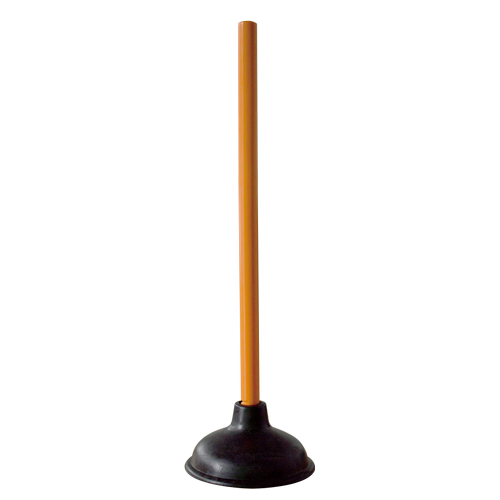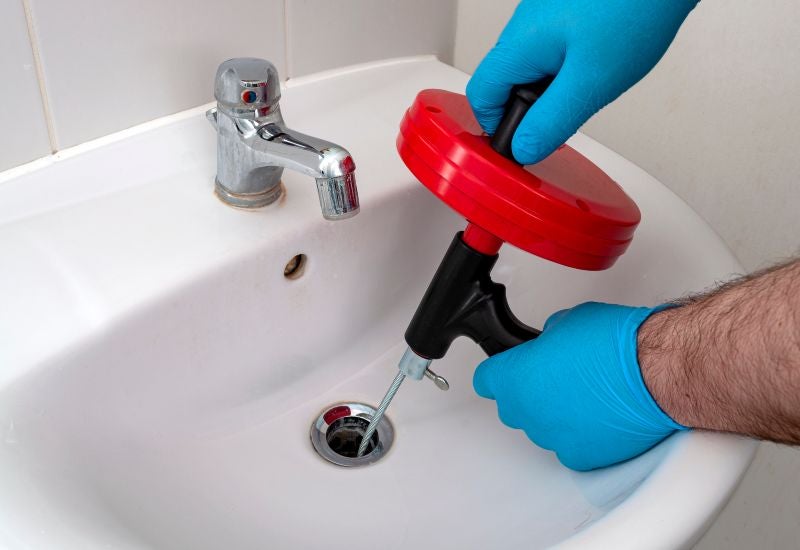Ways to Properly Apply Plunger and Drain Cleaners: Expert Guidance
Ways to Properly Apply Plunger and Drain Cleaners: Expert Guidance
Blog Article
Nearly everybody will have their unique theory with regards to How to Use a Plunger to Unclog a Toilet or Drain.

Intro
Appropriate maintenance of house drains is essential for stopping clogs and guaranteeing smooth water flow. One of the trick devices in every property owner's toolkit is the plunger, together with various drainpipe cleansers created to take on stubborn obstructions efficiently. This write-up discovers how to make use of plungers and drainpipe cleansers efficiently to maintain your drains pipes flowing freely.
Section 1: Understanding Bettors
Sorts of Plungers
There are a number of sorts of bettors available, each created for different kinds of drains pipes and obstructs. One of the most usual kinds include cup bettors, flange bettors, and accordion plungers.
Exactly How Plungers Work
Bettors work on the principle of developing stress and suction to displace blockages. When correctly applied over a drain, they develop a vacuum that can pull out debris or break up clogs.
Choosing the Right Bettor
Choosing the ideal bettor depends upon the sort of drain and the nature of the clog. Mug bettors are perfect for sinks and tubs, while flange bettors are better matched for bathrooms due to their design.
Typical Mistakes with Plungers
Avoiding these errors makes sure reliable plunging: incorrect seal around the drain, insufficient force, and not clearing surrounding debris.
Section 2: Utilizing Plungers Effectively
Prep work
Prior to diving, ensure the bettor covers the drain completely and develops a tight seal. Clear any kind of noticeable debris around the drainpipe opening.
Strategy
Start with gentle diving activities to develop suction. Boost stress slowly, utilizing a stable rhythm. Repeat as necessary up until the drainpipe removes.
Fixing Tips
If diving does not work, try adjusting the seal, applying oil jelly for a much better seal, or making use of a various sort of bettor.
Area 3: Understanding Drainpipe Cleansers
Types of Drain Cleaning Company
Drain cleaners can be chemical or enzymatic. Chemical cleaners use strong chemicals to dissolve blockages, while chemical cleansers use natural enzymes to break down organic matter.
How Drainpipe Cleansers Work
Chemical cleansers respond with blockages to dissolve them, while chemical cleansers break down natural products like hair and oil without harming pipes.
Safety Factors to consider
Constantly wear gloves and eye protection when utilizing chemical drainpipe cleansers. Make sure sufficient ventilation and follow manufacturer directions carefully.
Eco-Friendly Alternatives
Think about making use of vinegar and cooking soda or enzyme-based cleaners for environmentally friendly choices that are more secure for pipelines and the setting.
Area 4: Making Use Of Drain Cleaning Company Effectively
Application Strategies
Pour chemical cleaners directly right into the drain opening. Allow them to help the suggested time prior to flushing with warm water. Enzymatic cleansers must sit overnight.
Safety measures
Prevent mixing various sorts of cleaners, as this can produce hazardous fumes. Never utilize chemical cleansers combined with a plunger, as splashing can happen.
Dealing With Stubborn Clogs
For relentless clogs, think about using a plumbing snake or calling a professional plumbing to stop damage to pipes.
Verdict
Finally, comprehending just how to utilize bettors and drainpipe cleansers properly is vital for preserving healthy and balanced pipes systems. By choosing the right devices and strategies, house owners can deal with minor blockages and avoid major plumbing problems down the line.
How To Properly Use A Plumbing Snake To Clear Drains
When any drain clogs in our home arise, we tend to gravitate toward the plunger and little else. In cases where the plunger and its vacuum-created pressure are not able to clear clogs, many immediately move to harmful chemicals or simply call their plumber to fix the issue.
we’re happy to help with all drain cleaning needs and concerns. This includes informing you on a few other home remedies you may have at your disposal for minor to moderate clogs, one of which is the use of a plumbing snake. Many people have never used one of these before – let’s go over the steps to take when your drain clogs and you have a plumbing snake available.
Attempt Plunger Use
The first step here, as we noted above, should indeed be to grab your plunger when you notice a drain clog and attempt to resolve it this way. If you’re unsure how to use a particular type of plunger, our plumbers can answer any questions you have. If this doesn’t do the trick, however, you move on to the snake.
Locate And Prepare Snake
A plumbing snake is a metal or plastic device that’s generally about a quarter of an inch thick. It’s design with significant extensions, meant to reach down into your clogged drain and push the clog out. Snakes also contain drain augers that will latch onto and push stubborn blockages.
If your plunger doesn’t clear a clog, locate your snake and bring it to the drain in question. We also recommend keeping a bucket nearby to collect the clog once you pull it out, plus we’d advise wearing goggles and possibly protective gloves.
Feed Snake
Once you’re ready to go, feed the snake slowly down the drain, using the crank device it comes with to keep it moving until it finds the clog. Once this happens, much of the clog will be latched onto the coil so you can pull it out, while the rest will simply break up and flow downward.
Detach Debris
Remove the snake slowly from the drain, and once you’ve done so, pick off any debris that’s stuck to the coil. This is another area where wearing gloves is a must.
Flush Drain
Finally, take a few minutes to ensure the snake has done its job correctly. If you’ve been using it on a toilet, flush the toilet a couple times and make sure everything flows well. If you’ve used it on a different drain, flush it with some room temperature water.
https://www.mybuddytheplumber.com/blog/how-to-properly-use-a-plumbing-snake-to-clear-drains/

Application Strategies
Pour chemical cleaners directly right into the drain opening. Allow them to help the suggested time prior to flushing with warm water. Enzymatic cleansers must sit overnight.
Safety measures
Prevent mixing various sorts of cleaners, as this can produce hazardous fumes. Never utilize chemical cleansers combined with a plunger, as splashing can happen.
Dealing With Stubborn Clogs
For relentless clogs, think about using a plumbing snake or calling a professional plumbing to stop damage to pipes.
Verdict
Finally, comprehending just how to utilize bettors and drainpipe cleansers properly is vital for preserving healthy and balanced pipes systems. By choosing the right devices and strategies, house owners can deal with minor blockages and avoid major plumbing problems down the line.
How To Properly Use A Plumbing Snake To Clear Drains
When any drain clogs in our home arise, we tend to gravitate toward the plunger and little else. In cases where the plunger and its vacuum-created pressure are not able to clear clogs, many immediately move to harmful chemicals or simply call their plumber to fix the issue.
we’re happy to help with all drain cleaning needs and concerns. This includes informing you on a few other home remedies you may have at your disposal for minor to moderate clogs, one of which is the use of a plumbing snake. Many people have never used one of these before – let’s go over the steps to take when your drain clogs and you have a plumbing snake available.
Attempt Plunger Use
The first step here, as we noted above, should indeed be to grab your plunger when you notice a drain clog and attempt to resolve it this way. If you’re unsure how to use a particular type of plunger, our plumbers can answer any questions you have. If this doesn’t do the trick, however, you move on to the snake.
Locate And Prepare Snake
A plumbing snake is a metal or plastic device that’s generally about a quarter of an inch thick. It’s design with significant extensions, meant to reach down into your clogged drain and push the clog out. Snakes also contain drain augers that will latch onto and push stubborn blockages.
If your plunger doesn’t clear a clog, locate your snake and bring it to the drain in question. We also recommend keeping a bucket nearby to collect the clog once you pull it out, plus we’d advise wearing goggles and possibly protective gloves.
Feed Snake
Once you’re ready to go, feed the snake slowly down the drain, using the crank device it comes with to keep it moving until it finds the clog. Once this happens, much of the clog will be latched onto the coil so you can pull it out, while the rest will simply break up and flow downward.
Detach Debris
Remove the snake slowly from the drain, and once you’ve done so, pick off any debris that’s stuck to the coil. This is another area where wearing gloves is a must.
Flush Drain
Finally, take a few minutes to ensure the snake has done its job correctly. If you’ve been using it on a toilet, flush the toilet a couple times and make sure everything flows well. If you’ve used it on a different drain, flush it with some room temperature water.
https://www.mybuddytheplumber.com/blog/how-to-properly-use-a-plumbing-snake-to-clear-drains/

I came across that blog posting on Tips on How to Effectively Use a Plunger while doing a lookup on the internet. Make sure you pause to promote this blog if you enjoyed reading it. Bless you for your time. Don't hesitate to check up our website back soon.
Give Me A Quote! Report this page